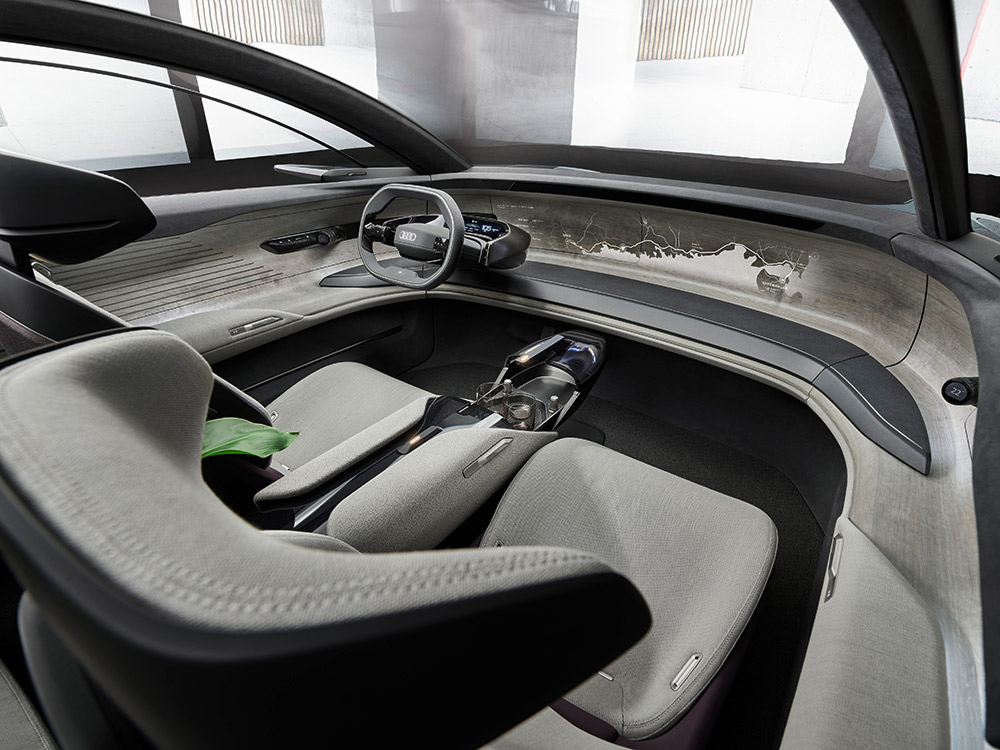你有沒(méi)有想過(guò),,坐在豪華私人飛機(jī)一般的舒適環(huán)境中,,閉上眼睛,身前的汽車方向盤自動(dòng)轉(zhuǎn)動(dòng)著,,是什么樣的感覺(jué),?
德國(guó)汽車制造商奧迪正在試圖將競(jìng)爭(zhēng)對(duì)手特斯拉和梅賽德斯-奔馳從高端汽車行業(yè)的尖頂上趕下來(lái)。9月2日,,奧迪發(fā)布了“Grandsphere”概念車,,回答了這一問(wèn)題。
奧迪發(fā)布了登月系列電動(dòng)汽車Artemis的外觀,。這一大眾集團(tuán)旗下的最新技術(shù)力作,,將于2025年正式面世,。
“這是一輛主要由內(nèi)而外構(gòu)思的汽車,但外觀卻很是可愛(ài),?!眾W迪的首席執(zhí)行官馬庫(kù)斯·杜斯曼在一次新聞發(fā)布會(huì)上告訴記者,“Grandsphere的概念很好地指明了Artemis系列車型生產(chǎn)版本的發(fā)展方向,?!?/p>
奧迪表示,這款長(zhǎng)5.35米,、寬2米的概念車甚至比奧迪A8旗艦車的加長(zhǎng)版本還要大,,會(huì)給司機(jī)和乘客一種在云端乘坐頭等艙的感覺(jué)。

Artemis將是奧迪首次進(jìn)入自動(dòng)駕駛汽車領(lǐng)域,。這款車最終將為司機(jī)提供一種奢侈的體驗(yàn)——如果他們?cè)敢獾脑?,可以關(guān)閉自己的思緒,進(jìn)入夢(mèng)鄉(xiāng),。
這種邊開車邊睡覺(jué)的自由,,只有在業(yè)內(nèi)被稱為“Level 4”的全自動(dòng)駕駛模式下才能夠?qū)崿F(xiàn)。這也是奧迪在2025年至2030年的努力方向,。
比如,當(dāng)司機(jī)想要把控制權(quán)交給汽車時(shí),,方向盤會(huì)消失在汽車的前面板中,,但只需要一個(gè)手勢(shì)就又可以把它“呼喚”回來(lái)。
汽車內(nèi)飾中的木材,、羊毛織物和金屬,,給人一種身處自然的感覺(jué);而黑色的觸屏顯示器被集成到汽車中的圖像所取代,,給人一種電影般的體驗(yàn),。奧迪表示,車內(nèi)沒(méi)有任何皮革制品,,“符合人們對(duì)奢侈品的先進(jìn)理解”,。
這款巨大的23英寸車輪可以支持120千瓦時(shí)電池的底盤的安裝,一次充電能夠讓汽車行駛超過(guò)750公里,。
這一概念車還有一個(gè)特點(diǎn),,即車門可以向相反的方向打開,就像四輪馬車一樣,。這一設(shè)計(jì)消除了中間支柱(原用以為碰撞情形提供結(jié)構(gòu)剛性),,從而給車內(nèi)帶來(lái)了更大的空間感。而這一備受喜愛(ài)的設(shè)計(jì)元素,,幾乎從未投入生產(chǎn)過(guò),。

這并不是奧迪第一次承諾自動(dòng)駕駛功能,。2017年,奧迪推出了目前的A8車型,,并推出了世界上首款“可移開視線”的“Level 3”級(jí)別的高自動(dòng)化駕駛技術(shù),。在高速公路低速行駛等情況下,司機(jī)不再需要監(jiān)督車輛,,倘若發(fā)生事故,,責(zé)任將直接轉(zhuǎn)移到汽車制造商。
這一功能在歐洲過(guò)于先進(jìn),,因此未能得到監(jiān)管程序的批準(zhǔn),,這項(xiàng)功能也就一直處于休眠狀態(tài)。直到三年后,,監(jiān)管機(jī)構(gòu)堅(jiān)持要求奧迪在尾部安裝攝像頭,,以檢測(cè)從后面靠近的緊急車輛,奧迪才最終放棄了自己的野心,。
相比之下,,特斯拉采取的方法不同,傾向于最大限度地增加車輛激活其完全自動(dòng)駕駛(Full Self-Driving)系統(tǒng)能力的情況,。盡管美國(guó)正在進(jìn)行聯(lián)邦安全調(diào)查,,目前,特斯拉正在復(fù)雜的城市環(huán)境中測(cè)試完全自動(dòng)駕駛系統(tǒng),,讓客戶作為測(cè)試駕駛員,。由于該公司的首席執(zhí)行官埃隆·馬斯克拒絕承擔(dān)責(zé)任,車主必須承擔(dān)事故中造成的任何損失,,導(dǎo)致其必須隨時(shí)都要監(jiān)督車輛,。這意味著,完全自動(dòng)駕駛系統(tǒng)只是一個(gè)二級(jí)輔助系統(tǒng),,并不能提供真正的自動(dòng)駕駛功能,。
在法律可行性方面存在的風(fēng)險(xiǎn)和不確定性,也是奧迪不希望在2025年推出這款車時(shí)提供“Level 4”自動(dòng)駕駛功能的原因之一,。(財(cái)富中文網(wǎng))
編譯:楊二一
你有沒(méi)有想過(guò),,坐在豪華私人飛機(jī)一般的舒適環(huán)境中,閉上眼睛,,身前的汽車方向盤自動(dòng)轉(zhuǎn)動(dòng)著,,是什么樣的感覺(jué)?
德國(guó)汽車制造商奧迪正在試圖將競(jìng)爭(zhēng)對(duì)手特斯拉和梅賽德斯-奔馳從高端汽車行業(yè)的尖頂上趕下來(lái),。9月2日,,奧迪發(fā)布了“Grandsphere”概念車,回答了這一問(wèn)題。
奧迪發(fā)布了登月系列電動(dòng)汽車Artemis的外觀,。這一大眾集團(tuán)旗下的最新技術(shù)力作,,將于2025年正式面世。
“這是一輛主要由內(nèi)而外構(gòu)思的汽車,,但外觀卻很是可愛(ài),。”奧迪的首席執(zhí)行官馬庫(kù)斯·杜斯曼在一次新聞發(fā)布會(huì)上告訴記者,,“Grandsphere的概念很好地指明了Artemis系列車型生產(chǎn)版本的發(fā)展方向,。”
奧迪表示,,這款長(zhǎng)5.35米,、寬2米的概念車甚至比奧迪A8旗艦車的加長(zhǎng)版本還要大,會(huì)給司機(jī)和乘客一種在云端乘坐頭等艙的感覺(jué),。
Artemis將是奧迪首次進(jìn)入自動(dòng)駕駛汽車領(lǐng)域,。這款車最終將為司機(jī)提供一種奢侈的體驗(yàn)——如果他們?cè)敢獾脑挘梢躁P(guān)閉自己的思緒,,進(jìn)入夢(mèng)鄉(xiāng),。
這種邊開車邊睡覺(jué)的自由,只有在業(yè)內(nèi)被稱為“Level 4”的全自動(dòng)駕駛模式下才能夠?qū)崿F(xiàn),。這也是奧迪在2025年至2030年的努力方向,。
比如,當(dāng)司機(jī)想要把控制權(quán)交給汽車時(shí),,方向盤會(huì)消失在汽車的前面板中,,但只需要一個(gè)手勢(shì)就又可以把它“呼喚”回來(lái)。
汽車內(nèi)飾中的木材,、羊毛織物和金屬,給人一種身處自然的感覺(jué),;而黑色的觸屏顯示器被集成到汽車中的圖像所取代,,給人一種電影般的體驗(yàn)。奧迪表示,,車內(nèi)沒(méi)有任何皮革制品,,“符合人們對(duì)奢侈品的先進(jìn)理解”。
這款巨大的23英寸車輪可以支持120千瓦時(shí)電池的底盤的安裝,,一次充電能夠讓汽車行駛超過(guò)750公里,。
這一概念車還有一個(gè)特點(diǎn),即車門可以向相反的方向打開,,就像四輪馬車一樣,。這一設(shè)計(jì)消除了中間支柱(原用以為碰撞情形提供結(jié)構(gòu)剛性),從而給車內(nèi)帶來(lái)了更大的空間感,。而這一備受喜愛(ài)的設(shè)計(jì)元素,,幾乎從未投入生產(chǎn)過(guò),。
這并不是奧迪第一次承諾自動(dòng)駕駛功能。2017年,,奧迪推出了目前的A8車型,,并推出了世界上首款“可移開視線”的“Level 3”級(jí)別的高自動(dòng)化駕駛技術(shù)。在高速公路低速行駛等情況下,,司機(jī)不再需要監(jiān)督車輛,,倘若發(fā)生事故,責(zé)任將直接轉(zhuǎn)移到汽車制造商,。
這一功能在歐洲過(guò)于先進(jìn),,因此未能得到監(jiān)管程序的批準(zhǔn),這項(xiàng)功能也就一直處于休眠狀態(tài),。直到三年后,,監(jiān)管機(jī)構(gòu)堅(jiān)持要求奧迪在尾部安裝攝像頭,以檢測(cè)從后面靠近的緊急車輛,,奧迪才最終放棄了自己的野心,。
相比之下,特斯拉采取的方法不同,,傾向于最大限度地增加車輛激活其完全自動(dòng)駕駛(Full Self-Driving)系統(tǒng)能力的情況,。盡管美國(guó)正在進(jìn)行聯(lián)邦安全調(diào)查,目前,,特斯拉正在復(fù)雜的城市環(huán)境中測(cè)試完全自動(dòng)駕駛系統(tǒng),,讓客戶作為測(cè)試駕駛員。由于該公司的首席執(zhí)行官埃隆·馬斯克拒絕承擔(dān)責(zé)任,,車主必須承擔(dān)事故中造成的任何損失,,導(dǎo)致其必須隨時(shí)都要監(jiān)督車輛。這意味著,,完全自動(dòng)駕駛系統(tǒng)只是一個(gè)二級(jí)輔助系統(tǒng),,并不能提供真正的自動(dòng)駕駛功能。
在法律可行性方面存在的風(fēng)險(xiǎn)和不確定性,,也是奧迪不希望在2025年推出這款車時(shí)提供“Level 4”自動(dòng)駕駛功能的原因之一,。(財(cái)富中文網(wǎng))
編譯:楊二一
Ever wondered what it might be like to sit back and get some shut eye in the relaxing ambience of a luxury private jet…only while sitting behind the wheel of a moving vehicle?
In its quest to topple rivals Tesla and Mercedes-Benz from the top of the premium car industry, German automaker Audi attempted to answer that question on September 2 with its "Grandsphere" concept.
It offers a glimpse of what its moonshot electric vehicle, previously known as “Artemis,” will look like when the Volkswagen Group brand’s technological tour-de-force is scheduled to arrive in 2025.
"It's a car that was predominantly conceived from the interior outward, and yet has a lovely exterior form," CEO Markus Duesmann told reporters in a briefing. "The Grandsphere gives a very good indication of the direction the series production version of the Artemis will take."
The 5.35-meter (17.6 feet) long and 2-meter wide concept, larger than even the stretch version of its A8 flagship sedan, should offer the feeling of traveling first class in the clouds, the company said.
Artemis will be the carmaker’s first entry into the autonomous vehicle space, eventually offering drivers the luxury of switching their minds off and drifting off to sleep if they so choose.
This kind of freedom to sleep while at the wheel only comes with fully automated driving known within the industry as “Level 4,” which Audi is developing for the second half of the decade.
When the driver wants to transfer control over to the vehicle, for example, the steering wheel disappears into the vehicle’s front panel, while a gesture of the hand is all that is needed to coax it back out.
Wood, wool fabrics, and metal give the feeling of a natural environment while black touchscreen displays are replaced by images integrated into the car to give a cinema-like experience. No leather can be found anywhere in the vehicle "in keeping with a progressive understanding of luxury," according to the company.
The massive 23-inch wheels support a chassis equipped with a 120 kilowatt hour battery capable of powering the vehicle across a distance of over 750 kilometers (466 miles) on one charge.
The concept features doors that open up in opposite directions like a coach wagon. This beloved design element, which rarely if ever makes it to production, gives a greater feeling of interior roominess by doing away with the middle pillar that provides structural rigidity to the vehicle in the event of a crash.
This isn’t the first time Audi has promised self-driving features. In 2017, it launched the current A8 with the world’s first “eyes-off” Level 3 highly-automated driving. In certain circumstances, such as highway driving at slow speeds, the driver was no longer required to supervise the vehicle and liability in the event of a crash transfers to the manufacturer.
It was so advanced for Europe that there was no regulatory process to approve it, so the feature remained dormant until three years later, when Audi buried its ambitions definitively after regulators insisted it needed a camera in the rear to detect emergency vehicles approaching from behind.
Tesla by comparison has taken a different approach, preferring to maximize the number of cases when a vehicle can activate its Full Self-Driving (FSD) systems capabilities. Currently, it's testing FSD in complex urban environments, using its customers as test drivers, despite a federal safety probe in the U.S. Since CEO Elon Musk refuses to accept liability, the cars' owners pick up the tab for any damages incurred in an accident and must therefor supervise the vehicle at all times. That means FSD is only a Level 2 assistance system, rather than offering true automated driving.
Risks and uncertainties regarding what will legally be possible is one reason why Audi does not expect to offer Level 4 self-driving capabilities when the vehicle is due to launch in 2025.






